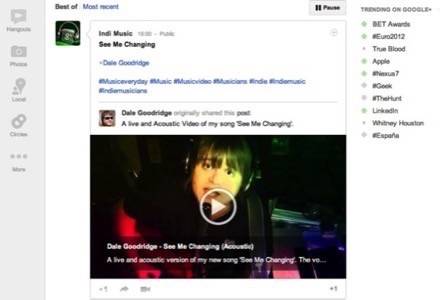
One year ago, Google+ launched to the world and was greeted with the collective cry, “Not another social network!” But over the past year Google+ has cemented its position as one of the Big Three social networks, alongside Facebook and Twitter. Or has it? Google+ boasts similar user numbers to Twitter, but if we look more closely we see that Google+ hasn’t lived up to its initial promise as a new type of social network. In fact, it’s morphed into something completely different for Google…
First the statistics, at least those presented to us by the corporations involved. 150 million people log in at least once a month to Google+, with half of those signing in daily. As a comparison, Facebook has 900 million “monthly active users” and Twitter has 140 million “active users.” So Facebook is the 900-pound gorilla of social networking.
Let’s now review how Google+ has evolved over the past year and whether it delivered on its promise.
Have Circles Actually Worked?

When Google+ launched, the key differentiating feature was Circles – which let you privately share and view content to and from groups of people. Twitter is a largely public network and at the time Google+ launched, Facebook was actively encouraging more of its users to share things publicly. Also, one year ago, it was difficult for Facebook users to create groups of people and selectively share things.
However, over the past year Facebook has countered Google+ Circles by making it easier to create and maintain lists of people. In fact, Facebook’s “Smart Lists” feature is better implemented than Google+ Circles, because Facebook helps you automatically populate the lists.
Frankly, Circles hasn’t had the impact most people expected. While there are no hard statistics to prove this, I’d be surprised if large numbers of people actively create and curate their Circles. I gave up managing my Circles soon after launch, due to the manual effort involved. There has been no sign that Google+ will automate Circle management, so you’d have to give a +1 to Facebook on that front.
Interest Graph
On the bright side, where Google+ has clearly made inroads over Facebook is as an Interest Graph. In other words, Google+ is great for tracking topics that you care about.

While we concluded a couple of months ago that Twitter is a better Interest Graph, because more people use it that way and it’s very discussion focused, we also noted that Google+ has a lot of promise. On Google+ you can do more detailed, thoughtful posts than on Twitter. Both Google+ and Twitter have useful search facilities, enabling you to subscribe to topics.
Google+: The Social Glue Across Google Products
The biggest impact Google+ has had over the past year hasn’t been on consumers, as a standalone social network. Instead, Google+ has most impacted its host company: Google.
Over the past twelve months, Google+ has become the social glue across all of Google’s products. Search is still king with Google, but it’s now more social thanks to Google+. Likewise for YouTube, Blogger, Gmail and a raft of other Google products. Google+ is even an identity service for some of those products – for example, YouTube users can now opt to use their Google+ profile instead of their YouTube username.

As a Standalone Product, Google+ Has Disappointed – However, …
The fact that Google+ has 75 million daily users is testament to it being such a key part of Google’s more established and bigger properties – such as search and YouTube. As a standalone social network, Google+ still struggles to achieve the user engagement that Facebook and Twitter have. Facebook is where you go to see what your friends are up to, Twitter is the daily virtual water cooler. I wouldn’t go so far as to call it a ghost town, but as a social network Google+ isn’t where the action is. The action is on Facebook, Twitter, … and YouTube, Google search, Blogger and other Google products.
One year ago, I think we all expected Google+ to turn into a better standalone product than what we’ve got now. But despite that, Google+ has turned out to be incredibly useful to Google. If I was to project what Google+ will be like in July 2013, I’d guess it will be even less about being a standalone social network and even more about supporting YouTube, Google search et al. One hopes it will also have a better API, so that more third party services can utilize that Google+ glue.
Do you agree that the future of Google+ is as a social glue, or do you think Google+ will develop into a better standalone product?

















